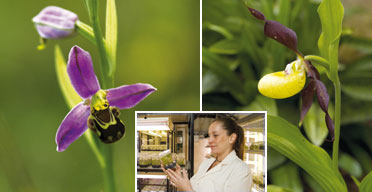
We often hear warnings in the media about the destruction of the world's tropical rainforests and coral reefs, but there is less coverage of the plight of Britain's flora. At the start of the millennium Kew helped develop the global strategy for plant conservation. This framework links disparate plant conservation initiatives and outlines targets to be met by 2010, including goals for conserving the UK's 1,450 species. The aim is for 60% of the country's threatened plants to be conserved by the year 2010.
So far progress has been slow: in 2006 Kew, Plantlife International and the Joint Nature Conservation Committee warned that only 20% of threatened flowering plant species were currently recognised as priorities for conservation. "We are finding it a challenge to meet these ambitious targets, even here in the UK with a relatively small and well-documented flora," said Kew's then director, Sir Peter Crane. "This makes us all the more aware of the greater challenge faced by our counterparts in tropical countries with far greater plant diversity and much more limited resources."
Millennium Seed Bank
As you would expect, Kew is at the forefront of efforts to conserve Britain's plants. The initial goal of the Millennium Seed Bank at Wakehurst Place was to store seeds from the entire British flora. It has now achieved that, apart from a few elusive species. "We've got 96%," says Steve Alton, UK coordinator in the seed bank's Conservation Department. "Of the remaining 4%, some of those are things that can't be banked, such as our two native oak species, the sessile oak (quercus petraea) and the pedunculate or English oak (quercus robur). They can't be stored because, like 15% of the world's flora, their seeds won't tolerate being dried."
Other tricky customers include a plant called the yellow star of Bethlehem. "It's not so rare that people know exactly where it is, and it's not so common that you can just go out and find it. It's small and flowers in March, when people aren't usually looking, and by the time the seeds are produced, the vegetation has grown really tall, so you can't see it. Added to that, slugs like it, so if you do find it, there's a good chance that the seed pods will have been eaten. The plant's got everything going wrong for it, but we will get it eventually."
The value of storing seeds is evident when you visit the micropropagation laboratory at Kew. Tucked away behind Climbers and Creepers [Kew's interactive learning centre] on the western edge of the gardens, this is where staff such as Grace Prendergast and Jenny Rowntree spend hours coaxing stubborn seeds into life in the hope of saving their species from the brink of extinction. In chilled rooms, row upon row of jars contain these premature babies of the plant world.
Sometimes it takes staff years to work out what conditions are required to make a seed turn into a plant, but once they've cracked it, the potential for success is great. For example, what was the only remaining lady's slipper orchid (cypripedium calceolus) in the UK, a single plant in the north of England, has now been supplemented by 80 of Kew's home-grown seedlings.
"There's a warden who looks after the remaining plant in the wild and pollinates it by hand, taking the pollen and putting it on the stigma," explains Grace, scientific officer on the Sainsbury Orchid Conservation Project. "In some years it's had up to 15 flowers on it, so he's collected the seed pods and sent them to us at Kew."
From seed to plant
Gathering seeds is one thing, but turning them into healthy plants is another. For a start, the time at which they are gathered can be critical. When Grace first began trying to germinate seeds from the lady's slipper orchid she had no success at all. Then an orchid specialist in Canada got in touch to say he had been able to propagate another cypripedium species using immature seeds.
"Although the plant they were trying to germinate was a rare species in Canada, there were around 100 plants rather than just one, and they were able to conduct pollinations and collect the seed pods at different times to find out the best time to gather them," says Grace, "That turned out to be about 50 days after pollination, so we tried it here and it worked with the British one as well."
· This is an extract from Carolyn Fry's book The World of Kew, written to accompany the BBC2 series A New Year at Kew. To buy a copy for £18.99, plus p&p, click here.

